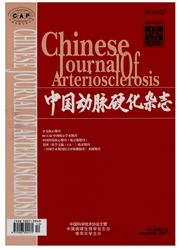

 中文摘要:
中文摘要:
目的结合冠状动脉造影结果,探讨冠心病患者外周血单个核细胞基质金属蛋白酶9、组织型金属蛋白酶抑制剂1和磷酸化c—Jun蛋白表达水平改变与冠状动脉病变特征的关系。方法40例经冠状动脉造影确诊的冠心病患者分为急性冠状动脉综合征组(n=24)和稳定型心绞痛组(n=16),另选取同期经冠状动脉造影证实无冠状动脉病变患者15例为对照组。采用免疫印迹法分别检测外周血单个核细胞基质金属蛋白酶9、组织型金属蛋白酶抑制剂l和磷酸化c-Jun蛋白表达水平,计算基质金属蛋白酶9/组织型金属蛋白酶抑制剂1比值,并结合Gensini冠状动脉病变积分标准评价其与冠状动脉管腔病变程度的线性关系及其在反映冠状动脉粥样硬化斑块稳定性中的作用。结果①急性冠状动脉综合征组基质金属蛋白酶9、组织型金属蛋白酶抑制剂1、磷酸化c—Jun蛋白表达水平及基质金属蛋白酶9/组织型金属蛋白酶抑制剂1比值较稳定型心绞痛组和对照组明显增高(均P〈0.001)。②基质金属蛋白酶9、磷酸化c-Jun及基质金属蛋白酶9/组织型金属蛋白酶抑制剂1比值与Gensini冠状动脉病变积分呈正相关(r分别为0.433、0.476和0.457,均P〈0.01);组织型金属蛋白酶抑制剂1蛋白表达水平与Gensini冠状动脉病变积分无相关性。③磷酸化c—Jun与基质金属蛋白酶9蛋白表达水平呈显著正相关(r=0.839,P〈0.001)。结论①急性冠状动脉综合征患者基质金属蛋白酶9、组织型金属蛋白酶抑制剂1蛋白表达水平较稳定型心绞痛患者明显增高,其比例严重失调,反映了急性冠状动脉综合征患者冠状动脉管腔病变程度更为复杂且血管壁具有更多易损斑块;②核转录因子c-Jun活化可能参与了动脉粥样硬化中基质金属蛋白酶9表达的调控。
 英文摘要:
英文摘要:
Aim To investigate the correlation between the protein expressions of matrix metalloproteinase-9 (MMP-9) , tissue inhibitor of metalloproteinase-1 ( TIMP-1 ) and phospho-e-Jun in peripheral blood mononuelear cells of patients with coronary heart disease and the characteristics of atherosclerosis plaque combined with the coronary angiography. Methods 55 patients who had coronary heart disease and underwent an immediate or selective coronary, angiography ( CAG ) were selected and divided into 3 groups : acute coronary syndrome ( ACS ) group ( n = 24 ) , stable angina ( SA ) group ( n = 16 ) and conrol group ( n = 15 ). MMP-9, TIMP-1 and phospho-c-Jun expressions in peripheral blood mononuclear cells were measured by Western-Blot. Coronary angiograms were scored according to Gensini integration and analysis of the relationship between MMP-9, TIMP-1, phospho-c-Jun, MMP-9/TIMP-1 and Gensini integration by linear correlation. Results (1)MMP-9, TIMP-1, phospho-c-Jun and MMP-9/TIMP-1 were significantly increased in ACS group than those in SA group and control group ( all P 〈 0. 001 ). (2)MMP-9, phospho-c-Jun and MMP-9/TIMP-1 were positively correlated with Gensini integration ( separately r = 0.433, r = 0.476, r = 0.457, all P 〈 0.01 ) , but there was no correlation between TIMP-1 and Gensini integration. (3)MMP-9 was greatly correlated with phospho-c-Jun in patients with coronary heart disease (r = 0.839, P 〈 0.001 ). Conclusions (1)MMP-9 and MMP-9/TIMP-1 were significantly increased but imbalanced in the patients with ACS, which suggested a prediction of more complex damage and more vulner- able plaque in coronary artery. (2)The activation of c-Jun may contribute to MMP-9 expression during the pathogenesis of atherosclerosis.
 同期刊论文项目
同期刊论文项目
 同项目期刊论文
同项目期刊论文
 期刊信息
期刊信息
